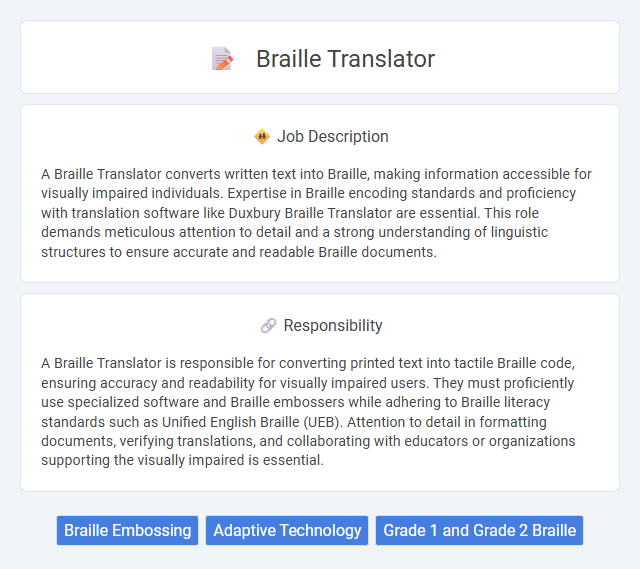
A Braille Translator converts written text into Braille, making information accessible for visually impaired individuals. Expertise in Braille encoding standards and proficiency with translation software like Duxbury Braille Translator are essential. This role demands meticulous attention to detail and a strong understanding of linguistic structures to ensure accurate and readable Braille documents.
Individuals with a keen attention to detail and proficiency in braille are likely to be suitable for a Braille Translator job, especially those who are visually impaired or have experience working closely with the visually impaired community. The role may be less suitable for individuals who struggle with linguistic precision or lack familiarity with braille systems and related assistive technologies. Those comfortable working with specialized software and possessing strong language skills may have a higher probability of excelling in this position.
Qualification
A Braille Translator job requires proficiency in Braille systems including Unified English Braille (UEB) and expertise in using Braille translation software such as Duxbury or BrailleBlaster. Candidates must demonstrate strong attention to detail, excellent literacy skills, and experience working with visually impaired individuals to ensure accurate and accessible tactile materials. Certification from recognized organizations like the Braille Authority of North America (BANA) enhances credibility and employment prospects in this specialized field.
Responsibility
A Braille Translator is responsible for converting printed text into tactile Braille code, ensuring accuracy and readability for visually impaired users. They must proficiently use specialized software and Braille embossers while adhering to Braille literacy standards such as Unified English Braille (UEB). Attention to detail in formatting documents, verifying translations, and collaborating with educators or organizations supporting the visually impaired is essential.
Benefit
A Braille Translator job likely offers the benefit of increasing accessibility for visually impaired individuals, enhancing their reading and learning experiences. Opportunities in this role may also provide a strong sense of fulfillment and social impact, contributing to inclusivity. Developing proficiency in specialized translation tools and languages might improve professional skills and marketability.
Challenge
The Braille Translator job is likely to present significant challenges related to accurately converting complex printed text into tactile Braille characters while preserving meaning and formatting. There is a strong probability that keeping up with various languages, specialized content, and evolving Braille standards will require continuous learning and attention to detail. Handling software limitations and ensuring accessibility for diverse users may also pose ongoing difficulties in this role.
Career Advancement
Braille Translators play a critical role in converting text into Braille, enabling accessibility for visually impaired individuals and opening pathways to specialized roles such as accessibility consultant or assistive technology trainer. Mastery of advanced Braille encoding systems and familiarity with digital transcription software significantly enhance career prospects and earning potential in this niche field. Pursuing certifications in accessibility and inclusive communication can further accelerate professional growth and leadership opportunities within educational institutions and advocacy organizations.
Key Terms
Braille Embossing
Braille Translator specialists convert printed text into braille codes optimized for accuracy and readability, facilitating accessibility for visually impaired individuals. Expertise in braille embossing involves operating and maintaining embossers that produce tactile braille documents with precise dot formations, ensuring high-quality, durable output. Proficiency in computer software tailored to braille translation and embossing technology is essential for seamless document conversion and efficient braille production workflows.
Adaptive Technology
A Braille Translator specializing in Adaptive Technology converts standard text into Braille to ensure accessibility for visually impaired users, utilizing advanced software tools designed for precision and efficiency. Expertise in assistive technology platforms such as screen readers and Braille embossers enhances the accuracy and usability of translated materials. This role emphasizes improving the integration of adaptive devices to facilitate seamless communication and learning experiences for individuals with visual disabilities.
Grade 1 and Grade 2 Braille
A Braille Translator specializes in converting text into Grade 1 and Grade 2 Braille, ensuring accessibility for visually impaired individuals. Grade 1 Braille represents each letter individually, ideal for learners and beginners, while Grade 2 Braille uses contractions and shorthand to increase reading speed and save space. Mastery of Braille rules and software tools enables the creation of accurate, readable Braille documents that support education and communication for the blind community.
 kuljobs.com
kuljobs.com